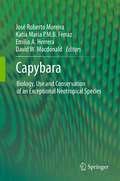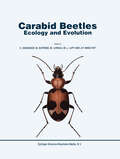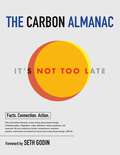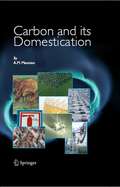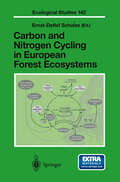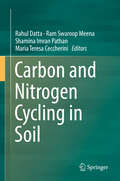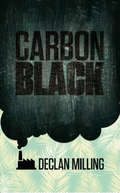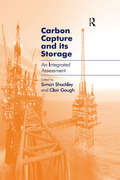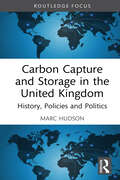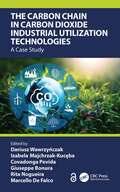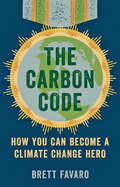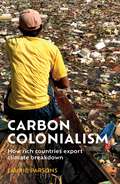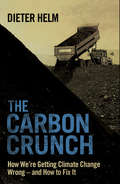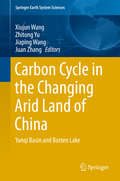- Table View
- List View
Capybara: Biology, Use and Conservation of an Exceptional Neotropical Species
by José Roberto Moreira, Katia Maria P. M. B. Ferraz, Emilio A. Herrera and David W. MacdonaldThe capybara is the neotropical mammal with the highest potential for production and domestication. Amongst the favorable characteristics for domestication we can list its high prolificacy, rapid growth rate, a herbivorous diet, social behavior and relative tameness. The genus (with only two species) is found from the Panama Canal to the north of Argentina on the east of the Andes. Chile is the only country in South America where the capybara is not found. The species is eaten all over its range, especially by poor, rural and traditional communities engaged in subsistence hunting. On the other hand, in large urban settlements wildlife is consumed by city dwellers as a delicacy. The sustainable management of capybara in the wild has been adopted by some South American countries, while others have encouraged capybara rearing in captivity.
Car Tourism (Economic Geography)
by Waldemar CudnyThis book examines the role of cars and the space connected with their production and presentation in tourism development. It describes the role played by experiences and experience societies formed in the 20th c. in the development of contemporary tourism, including tourism related to cars. The book explores the influence of experiencing unusual events, such as car races, car fairs, visits to car industry museums or multifunctional spaces connected with producing and exhibiting cars (e.g. Autostadt or Audi Forum) on the development of a new type of tourism, i.e. car tourism. This kind of tourism is novel in two ways: firstly, it is a new phenomenon in science, as so far it has not been thoroughly studied or described, apart from various short articles. Secondly, this type of tourism has developed on a large scale only in recent years, mainly due to the huge investments made by powerful European car manufacturers (e.g. Autostadt, Audi Forums, Porsche Museum, Lamborghini Museum etc.). The book presents cars and the spaces related to them as tourist assets (sites, events) and as tourist products that satisfy tourists’ needs. Moreover, it connects the issue of car tourism to the marketing strategies of large car manufacturers and discusses the theory of tourism space, highlighting the main tourism spaces in which car tourism develops. It presents multifunctional spaces (factories, adventure centres – Autostadt in Wolfsburg), museums, car exhibitions, and race tracks. In the next chapter, following an introduction to the problem of events, the author describes events related to car tourism, including races, rallies, driving schools and car fairs. The book ends with a summarizing chapter, which includes a model of the function of car tourism as a separate type of tourism, as well as a discussion presenting the main features, advantages and disadvantages of car tourism in the context of the tourism space theory.
Carabid Beetles: Ecology and Evolution (Series Entomologica #51)
by J-P. Maelfait K. Desender M. Dufrêne M. Loreau M. L. LuffCarbon: A Field Manual for Building Designers
by Matti Kuittinen Alan Organschi Andrew RuffA comprehensive approach to design that integrates sustainable principles and design strategies for decarbonized construction Representing an international collaboration between academics and architects in the United States and Europe, Carbon: A Field Manual for Designers and Builders offers professionals in the field an approach to sustainable design that embraces building science principles, life-cycle analysis, and design strategies in carbon neutral construction. The book also contains background information on carbon in construction materials and in the building design process. This book is filled with illustrative diagrams and drawings that help evaluate the potential impact of design decisions for creating carbon emissions. Written by and for designers and builders, the book includes a compelling pair of case studies that explore carbon-reducing strategies, suggests steps for assessing a building's carbon footprint, and reviews carbon storages and circulation of materials. The guidelines detailed in the book can be adopted, replicated, and deployed to reduce carbon emissions and create more sustainable buildings. This important book: Offers an effective approach to sustainable design in construction Integrates building science principles, life-cycle analysis, and design strategies in carbon neutral construction Describes a methodology for quantifying the flow of carbon in the built environment Provides an analysis of carbon-reducing strategies based on a case study of a building designed by the authors Written for practicing professionals in architecture and construction, Carbon: A Field Guide for Designers and Builders is a must-have resource for professionals who are dedicated to creating sustainable projects.
Carbon: A Field Manual for Building Designers
by Matti Kuittinen Alan Organschi Andrew RuffA comprehensive approach to design that integrates sustainable principles and design strategies for decarbonized construction Representing an international collaboration between academics and architects in the United States and Europe, Carbon: A Field Manual for Designers and Builders offers professionals in the field an approach to sustainable design that embraces building science principles, life-cycle analysis, and design strategies in carbon neutral construction. The book also contains background information on carbon in construction materials and in the building design process. This book is filled with illustrative diagrams and drawings that help evaluate the potential impact of design decisions for creating carbon emissions. Written by and for designers and builders, the book includes a compelling pair of case studies that explore carbon-reducing strategies, suggests steps for assessing a building's carbon footprint, and reviews carbon storages and circulation of materials. The guidelines detailed in the book can be adopted, replicated, and deployed to reduce carbon emissions and create more sustainable buildings. This important book: Offers an effective approach to sustainable design in construction Integrates building science principles, life-cycle analysis, and design strategies in carbon neutral construction Describes a methodology for quantifying the flow of carbon in the built environment Provides an analysis of carbon-reducing strategies based on a case study of a building designed by the authors Written for practicing professionals in architecture and construction, Carbon: A Field Guide for Designers and Builders is a must-have resource for professionals who are dedicated to creating sustainable projects.
The Carbon Almanac
by The Carbon Almanac NetworkWhen it comes to the climate, we don't need more marketing or anxiety. We need established facts and a plan for collective action.The climate is the fundamental issue of our time, yet it seems we can barely agree on what is really going on, let alone what needs to be done. We urgently need facts, not opinions. Insights, not statistics.The Carbon Almanac is a once-in-a-lifetime collaboration between hundreds of writers, researchers, thinkers, and leaders that focuses on what we know, what has come before, and what might happen next. With thousands of data points, articles and charts explaining carbon's impact on everything in our society, from our the economy to extreme weather events, it is the definitive source for facts and the basis for a global movement to fight climate change. This book isn't what the oil companies, marketers, activists, or politicians want you to believe. This is what's really happening, right now. Our planet is in trouble, and no one concerned group, corporation, country, or hemisphere canaddress this on its own. We are in this together. And it's not too late for concerted, collective action for change.
Carbon and Its Domestication
by A.M. MannionCarbon is a vital component of environmental and economic systems. Its unique chemistry makes it important biologically, geologically, and climatically. Its domestication in time and space has many manifestations, including the control of fire, development of agriculture, fossil-fuel use and biotechnology. All have exacted an environmental price. Many agencies exist to manage carbon through conservation, etc. Carbon management is now a highly charged international political issue in which energy provision is a primary factor. This cross-disciplinary text focuses on the pivotal role of carbon in society and in the environment.
Carbon and Nitrogen Cycling in European Forest Ecosystems (Ecological Studies #142)
by Ernst-Detlef SchulzeThis volume quantifies carbon storage in managed forest ecosystems not only in biomass, but also in all soil compartments. It investigates the interaction between the carbon and nitrogen cycles by working along a north-south transect through Europe that starts in northern Sweden, passes through a N-deposition maximum in central Europe and ends in Italy. For the first time biogeochemical processes are linked to biodiversity on a large geographic scale and with special focus on soil organisms. The accompanying CD-ROM provides a complete database of all flux, storage and species observations for modellers.
Carbon and Nitrogen Cycling in Soil
by Rahul Datta Ram Swaroop Meena Shamina Imran Pathan Maria Teresa CeccheriniSeveral textbooks and edited volumes are currently available on general soil fertility but‚ to date‚ none have been dedicated to the study of “Sustainable Carbon and Nitrogen Cycling in Soil.” Yet this aspect is extremely important, considering the fact that the soil, as the ‘epidermis of the Earth’ (geodermis)‚ is a major component of the terrestrial biosphere. This book addresses virtually every aspect of C and N cycling, including: general concepts on the diversity of microorganisms and management practices for soil, the function of soil’s structure-function-ecosystem, the evolving role of C and N, cutting-edge methods used in soil microbial ecological studies, rhizosphere microflora, the role of organic matter (OM) in agricultural productivity, C and N transformation in soil, biological nitrogen fixation (BNF) and its genetics, plant-growth-promoting rhizobacteria (PGPRs), PGPRs and their role in sustainable agriculture, organic agriculture, etc. The book’s main objectives are: (1) to explain in detail the role of C and N cycling in sustaining agricultural productivity and its importance to sustainable soil management; (2) to show readers how to restore soil health with C and N; and (3) to help them understand the matching of C and N cycling rules from a climatic perspective.Given its scope, the book offers a valuable resource for educators, researchers, and policymakers, as well as undergraduate and graduate students of soil science, soil microbiology, agronomy, ecology, and the environmental sciences. Gathering cutting-edge contributions from internationally respected researchers, it offers authoritative content on a broad range of topics, which is supplemented by a wealth of data, tables, figures, and photographs. Moreover, it provides a roadmap for sustainable approaches to food and nutritional security, and to soil sustainability in agricultural systems, based on C and N cycling in soil systems.
Carbon and Nutrient Fluxes in Continental Margins: A Global Synthesis (Global Change - The IGBP Series)
by Renato Quiñones Liana Talaue-McManus Kon-Kee Liu Larry AtkinsonThis book is a product of the joint JGOFS (Joint Global Ocean Flux Study)/LOICZ (Land–Ocean Interactions in the Coastal Zone) Continental Margins Task Team which was established to facilitate continental margins research in the two projects. It contains signi cant information on the physical, biogeochemical, and ecosystems of continental margins nationally and regionally and provides a very valuable synthesis of this information and the physical, biogeochemical and ecosystem processes which occur on continental margins. The publication of this book is timely as it provides a very strong foundation for the development of the joint IMBER (Integrated Marine Biogeochemistry and Ecosystems Research)/LOICZ Science Plan and Implemen- tion Strategy for biogeochemical and ecosystems research in the continental margins and the impacts of global change on these systems. This initiative will move forward integrated biogeochemical and ecosystems research in the continental margins. We thank all the contributors to this volume and especially Kon-Kee Liu who has dedicated a great deal of time to ensuring a high-quality book is published. IMBER Scienti c Steering Committee Julie Hall LOICZ Scienti c Steering Committee Jozef Pacyna v 1 Preface In general, interfaces between the Earth’s larger material reservoirs (i. e. , the land, atmosphere, ocean, and sediments) are important in the control of the biogeoche- cal dynamics and cycling of the major bio-essential elements, including carbon (C), nitrogen (N), phosphorus (P), sulfur (S), and silicon (Si), found in organic matter and the inorganic skeletons, shells, and tests of benthic and marine organisms.
Carbon Black
by Declan MillingIt's the end of the decade and the international response to climate change has defaulted to a piecemeal carbon market, which a new UN body is trying to make work. But the carbon market has become a battleground between anti-capitalist activists, now aggressively militant, and market proponents. And there are others, intent on protecting the status quo, and their financial interests in it. Emil Pfeffer, the new body's Director of Market Integrity, thinks he's making a difference, but he hasn't really left the comfort zone of his cocooned bureaucrat's existence. He's addressing C-World, the biggest carbon market conference and trade fair on the global circuit, when a questioner challenges the integrity of one of Emil's own staff, allegedly under arrest. Events half a world and, for Emil, an earlier lifetime away in Papua New Guinea are about to change everything. His cosseted, self-contained, somewhat self-satisfied world is about to be turned upside down. Risks need to be taken, sacrifices made, to achieve what is worth saving - his organisation's credibility and purpose. His colleagues' reputations. But then he realizes, it's his life that's on the line.
Carbon Capture and its Storage: An Integrated Assessment
by Clair GoughClimate change is arguably the most important environmental issue that the world currently faces. Carbon Capture and Storage (CCS) offers the possibility of significant reductions in the volume of CO2 released into the atmosphere in the near to medium term. As a fairly new technology that has not been widely adopted, there remain some uncertainties related to both viability and desirability. This book discusses the key issues with regard to technical and legal feasibility, economic viability and public and stakeholder perceptions. It also provides recommendations for policy and future research.
Carbon Capture and its Storage: An Integrated Assessment
by Clair GoughClimate change is arguably the most important environmental issue that the world currently faces. Carbon Capture and Storage (CCS) offers the possibility of significant reductions in the volume of CO2 released into the atmosphere in the near to medium term. As a fairly new technology that has not been widely adopted, there remain some uncertainties related to both viability and desirability. This book discusses the key issues with regard to technical and legal feasibility, economic viability and public and stakeholder perceptions. It also provides recommendations for policy and future research.
Carbon Capture and Storage in the United Kingdom: History, Policies and Politics (Routledge Focus on Energy Studies)
by Marc HudsonThis book is a concise but comprehensive guide to the history, present and possible futures of carbon capture and storage policy and action in the United Kingdom (UK).There have been multiple failed starts, promises and “last chances” for carbon capture and storage (CCS) in Europe, North America, China and Australia, but thus far it has repeatedly collided with the political and economic realities that the technology is too expensive and complicated to gain and keep policymakers’ support. However, in the UK that might be changing, with explicit government support for CCS to help decarbonise industry. Set within the broader context of global interest in CCS, this book first outlines the technologies involved in the types of capture technology, transport options and storage options in the UK. It then briefly introduces an overarching policy analysis framework (John Kingdon’s multiple streams approach) and uses it to give an account of the long history of CCS interest and efforts in three chapters covering the 1970s to 2002, 2003 to 2015 and 2016 to the present day. Marc Hudson focusses on the various arguments made for the introduction of CCS, and the slowly shifting coalitions of actors who make those arguments, while contrasting these with the perspectives of those opposed to CCS.This book will be of great interest to students, scholars and policymakers researching and working in the field, as well as the related areas of energy policy, energy transitions and climate change.
Carbon Capture and Storage in the United Kingdom: History, Policies and Politics (Routledge Focus on Energy Studies)
by Marc HudsonThis book is a concise but comprehensive guide to the history, present and possible futures of carbon capture and storage policy and action in the United Kingdom (UK).There have been multiple failed starts, promises and “last chances” for carbon capture and storage (CCS) in Europe, North America, China and Australia, but thus far it has repeatedly collided with the political and economic realities that the technology is too expensive and complicated to gain and keep policymakers’ support. However, in the UK that might be changing, with explicit government support for CCS to help decarbonise industry. Set within the broader context of global interest in CCS, this book first outlines the technologies involved in the types of capture technology, transport options and storage options in the UK. It then briefly introduces an overarching policy analysis framework (John Kingdon’s multiple streams approach) and uses it to give an account of the long history of CCS interest and efforts in three chapters covering the 1970s to 2002, 2003 to 2015 and 2016 to the present day. Marc Hudson focusses on the various arguments made for the introduction of CCS, and the slowly shifting coalitions of actors who make those arguments, while contrasting these with the perspectives of those opposed to CCS.This book will be of great interest to students, scholars and policymakers researching and working in the field, as well as the related areas of energy policy, energy transitions and climate change.
The Carbon Chain in Carbon Dioxide Industrial Utilization Technologies: A Case Study
by Dariusz Wawrzy 324 Czak Izabela Majchrzak-Kucę Ba Covadonga Pevida Giuseppe Bonura Rita Nogueira Marcello De FalcoA shift towards implementation of renewable energy has disadvantages, such as power availability, storage capacity, and accompanying costs, and therefore the potential of clean fossil fuel technologies to ensure the stability of electricity generation needs to be reconsidered until these challenges will be overcome. These clean technologies can help prevent the greenhouse effect and, at the same time, guarantee energy security, as coal is a widespread, price-stable raw material that is available in large quantities. This book focuses on the carbon chain, starting from the formation of CO2, through its capture, possible cleaning, to the production of useful products such as dimethylether, methanol, and carbonated cement prefabricates. The comprehensive case study presents the research results of an international team established within the "CCS-CCU technology for carbon footprint reduction using bio-adsorbents" (BIOCO2) project.
The Carbon Chain in Carbon Dioxide Industrial Utilization Technologies: A Case Study
by Dariusz WawrzyńczakA shift towards implementation of renewable energy has disadvantages, such as power availability, storage capacity, and accompanying costs, and therefore the potential of clean fossil fuel technologies to ensure the stability of electricity generation needs to be reconsidered until these challenges will be overcome. These clean technologies can help prevent the greenhouse effect and, at the same time, guarantee energy security, as coal is a widespread, price-stable raw material that is available in large quantities. This book focuses on the carbon chain, starting from the formation of CO2, through its capture, possible cleaning, to the production of useful products such as dimethylether, methanol, and carbonated cement prefabricates. The comprehensive case study presents the research results of an international team established within the "CCS-CCU technology for carbon footprint reduction using bio-adsorbents" (BIOCO2) project.
The Carbon Code: How You Can Become a Climate Change Hero
by Brett FavaroOur world is getting hotter, and it’s our fault. Our addiction to fossil fuels is destroying not only our ancient planet, but our modern civilization. How can we protect our fragile ecosystems while preserving our way of life? How can we respond to climate change deniers who mock the fact that environmental activists use fossil fuels? In short, how can your average concerned citizen live a normal life in a carbon-based economy without being justifiably called a hypocrite? In The Carbon Code, conservation biologist Brett Favaro answers these thorny questions, offering simple strategies to help you reduce your carbon footprintâ€�without abandoning common sense.Favaro’s Carbon Code of Conduct is based on the four Rs: Reduce, Replace, Refine, and Rehabilitate. After outlining the scientific basics of climate change and explaining the logic of the code he prescribes, the author describes carbon-friendly technologies and behaviors we can adopt in our daily lives. However, he acknowledges that individual action, while vital, is insufficient. To achieve global sustainability, he insists that we must make the fight against climate change "go viral" through conspicuous conservation.The Carbon Code is a tool of empowerment. People don’t need to be climate change experts to be part of the solution! In this book, Brett Favaro shows you how to take ownership of your carbon footprint and adopt a lifestyle of conspicuous conservation that will spur governments and corporations to do the same. Climate-friendly action is the best decision on every dimensionâ€�economics, health and well-being, and social justice. Saving the planet is, after all, about saving ourselves. The Carbon Code provides a framework to do this, and helps you to become a hero in the fight against climate change.
The Carbon Code: How You Can Become a Climate Change Hero
by Brett FavaroOur world is getting hotter, and it’s our fault. Our addiction to fossil fuels is destroying not only our ancient planet, but our modern civilization. How can we protect our fragile ecosystems while preserving our way of life? How can we respond to climate change deniers who mock the fact that environmental activists use fossil fuels? In short, how can your average concerned citizen live a normal life in a carbon-based economy without being justifiably called a hypocrite? In The Carbon Code, conservation biologist Brett Favaro answers these thorny questions, offering simple strategies to help you reduce your carbon footprintâ€�without abandoning common sense.Favaro’s Carbon Code of Conduct is based on the four Rs: Reduce, Replace, Refine, and Rehabilitate. After outlining the scientific basics of climate change and explaining the logic of the code he prescribes, the author describes carbon-friendly technologies and behaviors we can adopt in our daily lives. However, he acknowledges that individual action, while vital, is insufficient. To achieve global sustainability, he insists that we must make the fight against climate change "go viral" through conspicuous conservation.The Carbon Code is a tool of empowerment. People don’t need to be climate change experts to be part of the solution! In this book, Brett Favaro shows you how to take ownership of your carbon footprint and adopt a lifestyle of conspicuous conservation that will spur governments and corporations to do the same. Climate-friendly action is the best decision on every dimensionâ€�economics, health and well-being, and social justice. Saving the planet is, after all, about saving ourselves. The Carbon Code provides a framework to do this, and helps you to become a hero in the fight against climate change.
Carbon colonialism: How rich countries export climate breakdown (G - Reference,information And Interdisciplinary Subjects Ser.)
by Laurie ParsonsAround the world, leading economies are announcing significant progress on climate change. World leaders are queuing up to proclaim their commitment to tackling the climate crisis, pointing to data that shows the progress they have made. Yet the atmosphere is still warming at a record rate, with devastating effects on poverty and precarity in the world’s most vulnerable communities. Are we being deceived?Climate change is devastating the planet, and globalisation is hiding it. This book opens our eyes. Carbon colonialism explores the murky practices of outsourcing a country’s environmental impact, where emissions and waste are exported from rich countries to poorer ones; a world in which corporations and countries are allowed to maintain a clean, green image while landfills in the world’s poorest countries continue to expand, and droughts and floods intensify under the auspices of globalisation, deregulation and economic growth. Taking a wide-ranging, culturally engaged approach to the topic, the book shows how this is not only a technical problem, but a problem of cultural and political systems and structures – from nationalism to economic logic – deeply embedded in our society.
Carbon colonialism: How rich countries export climate breakdown
by Laurie ParsonsAround the world, leading economies are announcing significant progress on climate change. World leaders are queuing up to proclaim their commitment to tackling the climate crisis, pointing to data that shows the progress they have made. Yet the atmosphere is still warming at a record rate, with devastating effects on poverty and precarity in the world’s most vulnerable communities. Are we being deceived?Climate change is devastating the planet, and globalisation is hiding it. This book opens our eyes. Carbon colonialism explores the murky practices of outsourcing a country’s environmental impact, where emissions and waste are exported from rich countries to poorer ones; a world in which corporations and countries are allowed to maintain a clean, green image while landfills in the world’s poorest countries continue to expand, and droughts and floods intensify under the auspices of globalisation, deregulation and economic growth. Taking a wide-ranging, culturally engaged approach to the topic, the book shows how this is not only a technical problem, but a problem of cultural and political systems and structures – from nationalism to economic logic – deeply embedded in our society.
Carbon Counter: Calculate Your Carbon Footprint (Collins Gem)
by Mark LynasWhat effect are you having on the environment? If you buy Kenyan green beans what is the CO2 cost? What about your journey to work, your fridge or your clothes? The Gem Carbon Counter is your portable instant green reckoner.
The Carbon Crunch: Revised and Updated
by Dieter HelmIn a new edition of his hard-hitting book on climate change, economist Dieter Helm looks at how and why we have failed to tackle the issue of global warming and argues for a new, pragmatic rethinking of energy policy. “An optimistically levelheaded book about actually dealing with global warming.”—Kirkus Reviews, starred review “[Dieter Helm] has turned his agile mind to one of the great problems of our age: why the world’s efforts to curb the carbon dioxide emissions behind global warming have gone so wrong, and how it can do better.”—Pilita Clark, Financial Times
Carbon Cycle in the Changing Arid Land of China: Yanqi Basin and Bosten Lake (Springer Earth System Sciences)
by Xiujun Wang Zhitong Yu Jiaping Wang Juan ZhangThis book integrates the analyses of organic carbon and carbonate accumulation in soil and lake sediment in a typical arid region of China that has experienced significant climate and land-use changes.It demonstrates that carbonate accumulation greatly exceeds organic carbon in both soil and sediment. It also shows that intensive cropping with sound land management in the arid land not only increases soil organic carbon stock, but also enhances accumulation of soil carbonate, particularly in subsoils. Carbon accumulation in the lake sediment increased between 1950 and 2000, after which it declined, and the authors explore how human activity and climate change may have caused the changes in carbon burial in the lake sediment.This book is of interest to researchers in a number of fields such as soil science, limnology and global change, as well as to the policy-makers.
Carbon Cycle in the Russian Arctic Seas
by Alexander Vetrov Evgeny RomankevichThis study analyzes carbon-cycle conditions controlling the state of the Arctic ecosystem and their seasonal variations. Territory covered includes the Barents, White, Kara, Laptev, East-Siberian and Chukchi Seas, considering inter-correlations between sources of organic carbon, their fluxes, recycling and burial in bottom sediments. All biological communities (phythoplankton, macrophythobenthos, microphythobentos, bacterioplankton, zooplankton and zoobenthos) are taken into account regarding their participation in the carbon cycle.
